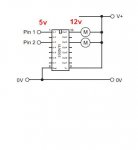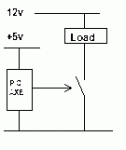RubiksRune
New Member
Hi.
Im trying to build this HDD clock http://www.ian.org/HD-Clock/
My picaxe is 5v, my RGB LEDs are 12v, and I have a ULN2803AG
In the tutorial above, he's using a ULN2003A, but the only different between mine and hes, is 7 and 8 darlington transistors..so mine should do the work as well?
anyhow, I can't figure out how he does it, how does he controll the 12v LED with the picaxe? I got 0v at ground, 12v at +, but the picaxe doesn't trigger the transistor.
Im trying to build this HDD clock http://www.ian.org/HD-Clock/
My picaxe is 5v, my RGB LEDs are 12v, and I have a ULN2803AG
In the tutorial above, he's using a ULN2003A, but the only different between mine and hes, is 7 and 8 darlington transistors..so mine should do the work as well?
anyhow, I can't figure out how he does it, how does he controll the 12v LED with the picaxe? I got 0v at ground, 12v at +, but the picaxe doesn't trigger the transistor.


